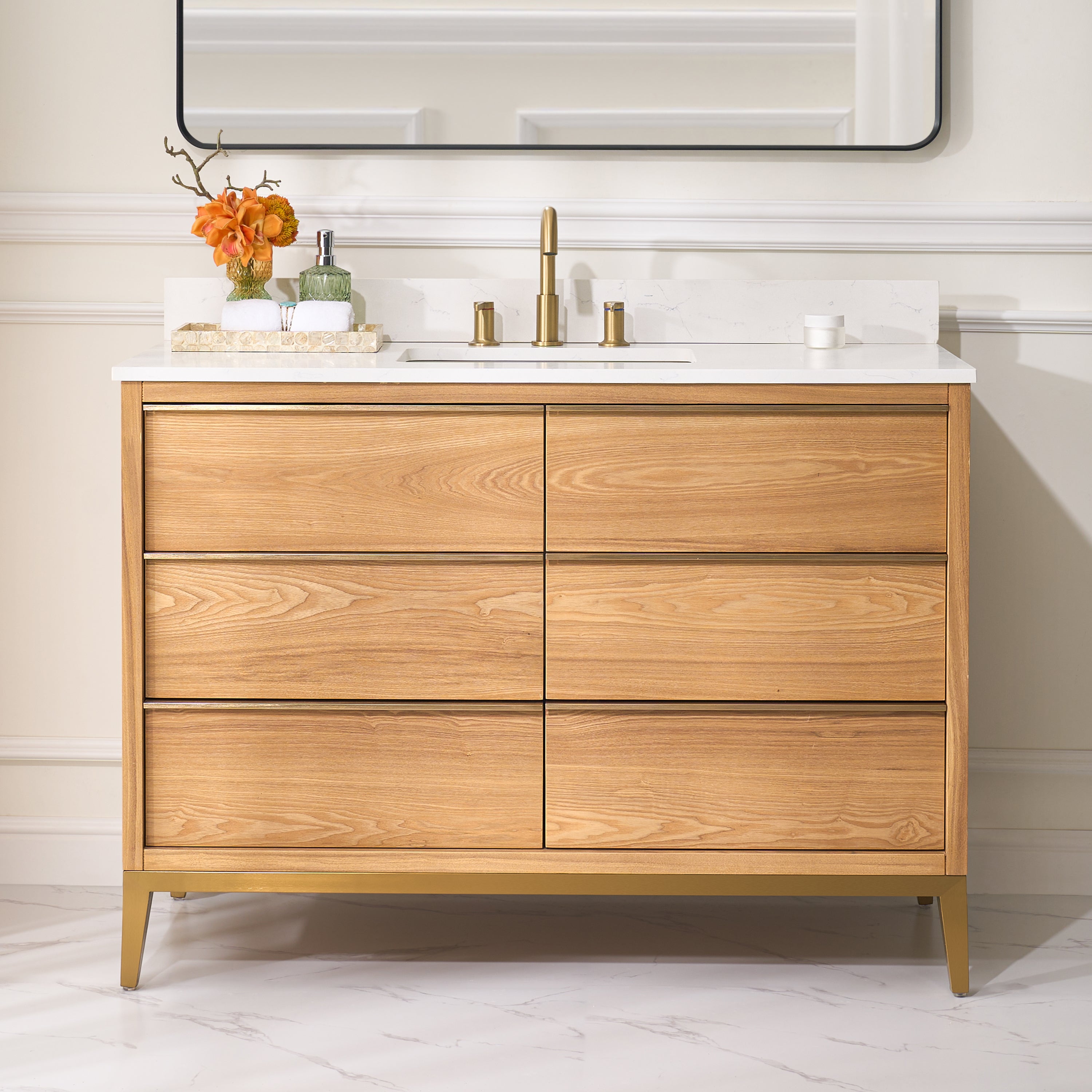Wood bathroom vanities add a touch of elegance to any home. However, they require special care to maintain their beauty and durability, especially in a high-moisture environment like the bathroom.
So, how do you protect your wood bathroom vanity? This is a question many homeowners grapple with.
This guide aims to provide practical tips and advice on how to maintain and protect your wood bathroom vanity. It covers everything from the importance of regular cleaning to the role of ventilation and humidity control.
Whether you have a small wood bathroom vanity with sink or a solid wood vanity, this guide has got you covered. It will help you understand the best practices for preserving the integrity and appearance of your vanity.
By the end of this guide, you'll be equipped with the knowledge to keep your wood bathroom vanity looking its best for years to come. Let's dive in.
Understanding the Importance of Vanity Protection
Protecting your wood bathroom vanity is crucial for several reasons. Wood is sensitive to moisture, which can cause warping, swelling, or even cracking. Without proper protection, constant exposure to bathroom humidity can significantly degrade the wood's quality.
A well-maintained wood vanity contributes not only to aesthetic appeal but also to functionality. A deteriorating vanity might result in costly repairs or even replacement. By understanding the importance of protection, you can take steps to ensure that your investment lasts, keeping your bathroom looking elegant and functioning efficiently. Your efforts in maintenance will pay off in long-term savings and satisfaction.
Selecting the Right Finish for Your Vanity
Choosing the right finish is essential for protecting your wood bathroom vanity. Different finishes offer varied levels of water resistance and protection. The right finish can enhance the natural beauty of the wood while providing a durable surface.
When selecting a finish, consider factors like durability, appearance, and ease of application. Some finishes are better suited for high-moisture environments. It's vital to match the finish to the vanity's specific needs, especially if you have a wood bathroom vanity with a sink.
Here’s a list of key considerations for selecting your finish:
-
Durability against moisture and humidity
-
Aesthetic match with your bathroom design
-
Ease of maintenance and reapplication
-
Environmental impact and safety
-
Compatibility with your wood type
Invest some time to understand these factors and consult with experts if needed. Ensuring the right finish will safeguard your vanity for years to come.
Types of Finishes and Their Benefits
Various finishes can protect your vanity. Varnish, polyurethane, and lacquer are popular for providing a hard, protective layer. Each has strengths and weaknesses, so choose based on your needs.
Varnish offers excellent protection and a glossy look. Polyurethane is known for its strength and resistance to scratches, making it ideal for high-traffic areas. Lacquer dries quickly and provides a sleek finish, suitable for contemporary designs. By understanding these options, you can better decide which finish will keep your vanity in top shape.
Regular Cleaning and Maintenance

Consistent care helps maintain your wood bathroom vanity's charm and durability. Cleaning regularly prevents buildup of grime and moisture that can damage the wood. A well-maintained vanity not only looks good but lasts longer.
Incorporate gentle cleaning routines into your weekly tasks. This minimizes the risk of water damage or staining. Avoid harsh chemicals that can strip the finish off your vanity.
Here are some key cleaning tips:
-
Use a soft cloth for dusting and wiping
-
Opt for mild, non-abrasive cleaners
-
Quickly clean up any water spills
-
Regularly inspect and wipe around sink areas
-
Avoid leaving wet items on the vanity
By following these tips, your vanity will remain in excellent condition, preserving its natural beauty and function.
Best Practices for Cleaning Wood Vanities
Cleaning your wood vanity requires a gentle touch and the right products. Start by using a soft cloth or microfiber towel to remove dust. Avoid using steel wool or rough sponges, which can scratch the finish.
Choose cleaning products specifically formulated for wood surfaces. Mild soap mixed with water or a dedicated wood cleaner is ideal. After applying the cleaner, promptly dry the surface to prevent moisture from soaking into the wood.
Pay attention to areas around the sink, as they are prone to water exposure. Quickly addressing spills and regularly checking for water stains will help protect the wood. These practices ensure your wood bathroom vanity retains its allure and remains a central piece in your bathroom.
The Role of Ventilation and Humidity Control
Ventilation plays a crucial role in preserving your wood bathroom vanity. Without it, bathrooms can become breeding grounds for mold and mildew. These issues can harm your vanity's wood surface over time.
Humidity in a bathroom can lead to wood warping or swelling. Maintaining a balanced humidity level is essential for avoiding such issues. It's important to control the environment to protect both the wood and its finish.
Using tools like a dehumidifier can significantly help. These devices manage moisture levels efficiently. Proper ventilation is the key to ensuring that your wood vanity remains beautiful and resilient.
Tips for Improving Bathroom Ventilation
Improving bathroom ventilation requires simple yet effective steps. Start by ensuring your exhaust fan is in good working condition. A high-quality fan removes excess moisture from the air quickly.
If your bathroom has a window, open it to allow fresh air in and let moisture out. This natural ventilation can drastically reduce humidity levels. Additionally, ceiling or portable fans help circulate air, keeping your bathroom dry.
Consider venting your fan to the outside rather than the attic. Proper ventilation helps extend the life of your wood vanity by preventing moisture-related issues. These changes create a healthier environment for your wood vanity and the entire bathroom space.
Sealants and Waterproofing Techniques
Sealants are essential for protecting your wood bathroom vanity from water damage. They create a barrier that prevents moisture from penetrating the wood. Using the right sealant ensures long-lasting protection against mold and rot.
When it comes to waterproofing, consider the type of wood and finish. Different woods require different sealants for optimal protection. Always research or consult a professional before application.
Explore various sealants on the market. Here are some options to consider:
-
Polyurethane: Offers a tough, water-resistant layer.
-
Varnish: Provides a hard and glossy finish.
-
Lacquer: Dries quickly and adds a durable sheen.
Each type has unique benefits and is suited for specific needs. Understanding these options will help you make the best choice.
How to Apply and Maintain Sealants
Begin by preparing the vanity surface. Clean it thoroughly to remove dust and grime. This step ensures that the sealant adheres properly and provides the best protection.
Once clean, apply the sealant using a brush or roller. Follow the manufacturer's instructions for best results. It's crucial to cover all exposed areas uniformly.
Regular maintenance involves checking the seal for wear and tear. Over time, the sealant may need reapplication. A timely touch-up can greatly extend the life of your wood vanity, keeping it safeguarded against moisture and humidity.
Protecting the Area Around the Sink
The area around the sink is highly susceptible to water exposure. Water splashes and spills are inevitable, especially in busy bathrooms. Therefore, it’s vital to focus on protecting this area to prevent damage.
One effective way to shield the wood is by using water-resistant mats or trays. These can catch drips and spills, minimizing direct contact with the wood. Select materials that are easy to clean and durable.
Additionally, installing a backsplash can further protect the surface from splashes. A well-fitted backsplash prevents water from seeping into the wood. Combining these methods can help maintain the vanity's beauty and integrity.
Caulk and Grout Maintenance
Caulking and grouting are essential in preventing water seepage. They act as seals that keep water out of crevices and joints. Regular maintenance of these seals is crucial for protecting your vanity.
Inspect caulk and grout lines for cracks or gaps regularly. Over time, these areas can deteriorate due to constant exposure to water and humidity. Reapply or replace them when they show signs of wear.
Use a high-quality, waterproof caulk for longevity. Make sure the surface is dry and clean before application. Properly maintained caulk and grout can keep the area around the sink secure, preventing moisture damage effectively.
Addressing Common Wood Vanity Issues
Wood bathroom vanities can face several issues due to environmental conditions. Understanding these problems helps in maintaining their longevity and beauty. Let's explore common challenges and their solutions.
Warping, swelling, and cracking are prevalent issues in wood vanities. These problems often arise due to moisture and inadequate maintenance. You can prevent these issues by following proper care guidelines.
Consider implementing routine checks to address problems early. Here are some common issues and their solutions:
-
Warping: Use dehumidifiers and maintain consistent humidity levels.
-
Swelling: Address leaks and clean spills promptly.
-
Cracking: Apply conditioners or oils to keep the wood hydrated.
With these measures, you can extend the life of your wood bathroom vanity.
How to Deal with Warping, Swelling, or Cracking
Addressing warping, swelling, or cracking requires prompt action. Warping often occurs when wood is exposed to uneven moisture. To combat this, ensure proper ventilation and control humidity using devices like dehumidifiers.
Swelling is typically due to prolonged exposure to water. Check for plumbing leaks and wipe up water spills immediately. Using a protective finish can also act as a barrier against moisture.
Cracking often results from the wood drying out. Regularly applying natural oils or wood conditioners can help maintain the wood's moisture levels. With careful attention and maintenance, these issues can be effectively minimized.
Final Thoughts: Embracing a Routine for Longevity
Maintaining a wood bathroom vanity requires consistent effort and care. By implementing a regular maintenance routine, you ensure its beauty and durability. Adopting these practices can significantly extend the life of your vanity.
Commit to cleaning your vanity using mild, non-abrasive cleaners. This simple step helps preserve the finish and prevent wear. Additionally, be proactive in handling spills and maintaining protective sealants.
Finally, adapt your lifestyle to support your vanity's needs. Embrace changes like controlling humidity and ensuring proper ventilation. With dedication to these practices, your wood bathroom vanity can continue to be a centerpiece in your space for years to come.
















Leave a comment
This site is protected by hCaptcha and the hCaptcha Privacy Policy and Terms of Service apply.